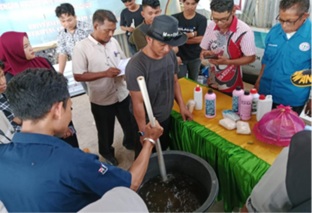Penerapan Budidaya Ikan Lele Sistem Bioflok pada BUMDes Bumi Paccelekang Sejahtera di Desa Paccelekang Kabupaten Gowa Sulawesi Selatan The Implementation System of Biofloc Catfish Farming at BUMDes Bumi Paccelekang Sejahtera in Paccelekang Village, Gowa Regency, South Sulawesi
Main Article Content
Abstract
Pattallassang District is a Mamminasata Metropolitan development area for urban settlements with an area of 5,983 Ha as an eastern Satellite City in Panaikang Village and Paccelekang Village, Pattallassang District. To improve the welfare of the people of Pacellekang Village, BUMDes Bumi Paccellekang Sejahtera (BUMDes BPS) was established, an agro-complex-based integrated tourist destination program. This Community Service activity aims to introduce innovative biofloc technology for catfish farming and provide technical guidance to catfish farming groups in Paccelekang Village through the biofloc system. The Community Service Program (PKM) was conducted in September 2024 in Paccelekang Village, targeting members of the BUMDes Paccelekang Sejahtera catfish farming group. The approach model used in this PKM program is Participatory Rural Appraisal (PRA). The results of the PKM activities, through counseling and training programs, show that on average, partners had a low level of knowledge and skills regarding biofloc catfish farming techniques, with 70% (21 members) categorized as low, and only 10% (3 members) and 20% (6 members) categorized as good and fair, respectively. However, after the counseling and training, the knowledge level of the partners improved, with 10% (3 members) still in the low category, and 10% (3 members) and 80% (24 members) now categorized as good and fair, respectively. Quantitatively, there was a significant improvement in partner knowledge after the counseling and training. Continuous assistance will be provided until the partners become proficient in managing and cultivating catfish using the biofloc system.
Downloads
Article Details

This work is licensed under a Creative Commons Attribution-ShareAlike 4.0 International License.
Authors who publish with this journal agree to the following terms:
- Any article on the copyright is retained by the author(s).
- Author grant the journal, right of first publication with the work simultaneously licensed under a Creative Commons Attribution License that allows others to share work with acknowledgment of the work authors and initial publications in this journal.
- Authors are able to enter into a separate, additional contractual arrangements for non-exclusive distribution of published articles of work (eg, post-institutional repository) or publish it in a book, with acknowledgment of its initial publication in this journal.
- Authors are permitted and encouraged to post their work online (e.g., in institutional repositories or on their websites) prior to and during the submission process, as can lead to productive exchanges, as well as earlier and greater citation of published work.
- The article and any associated published material is distributed under the Creative Commons Attribution-ShareAlike 4.0 International License
References
Adharani, N., Soewardi, K., Syakti, A. D., & Hariyadi, S. (2016). Manajemen Kualitas Air Dengan Teknologi Bioflok : Studi Kasus Pemeliharaan Ikan Lele (Clarias Sp.) (Water Quality Management Using Bioflocs Technology : Catfish Aquaculture (Clarias sp.). Jurnal Ilmu Pertanian Indonesia (JIPI), 21(April). https://doi.org/10.18343/jipi.21.1.35
Avnimelech, Y., & Kochba, M. (2009). Evaluation of nitrogen uptake and excretion by tilapia in bio fl oc tanks , using 15 N tracing. Aquaculture, 287(1–2), 163–168. https://doi.org/10.1016/j.aquaculture.2008.10.009
Ekasari, J., Handayani, T. N., Fauzi, I. A., Maulana, F., & Vinasyiam, A. (2022). Kontribusi bioflok terhadap pertumbuhan ikan lele yang diberi pakan dengan tingkat berbeda. Jurnal Riset Akuakultur, 17(2), 59–70. http://dx.doi.org/10.15578/jra.17.2.2022.59-70
Gaffar, A. A., Rasyid, A., & Suryaningsih, Y. (2020). Budidaya Ikan Lele Sangkuriang dengan Sistem Bioflok di Desa Jerukleueut Kecamatan Sindangwangi Kabupaten Majalengka. BERNAS: Jurnal Pengabdian Kepada Masyarakat, 1(3), 159–163. https://doi.org/10.31949/jb.v1i3.313
Hari, B., Kurup, B. M., Varghese, J. T., Schrama, J. W., & Verdegem, M. C. J. (2006). The effect of carbohydrate addition on water quality and the nitrogen budget in extensive shrimp culture systems. Aquaculture, 252, 248–263. https://doi.org/10.1016/j.aquaculture.2005.06.044
Kuhn, D. D., & Boardman, G. D. (2008). Use of Microbial Flocs Generated from Tilapia Effluent as a Nutritional Supplement for Shrimp , Litopenaeus vannamei , in Recirculating Aquaculture Systems. Journal of The World Aquaculture Society, 39(1), 72–82. http://dx.doi.org/10.1111/j.1749-7345.2007.00145.x
Pramono, T. B., Marnani, S., Soedirman, U. J., & Soedirman, U. J. (2018). Transfer Teknologi Bioflok pada Budi daya Ikan Lele : Upaya Peningkatan Produktivitas Usaha. Jurnal Agromix, 9(2), 83–88. https://doi.org/10.35891/agx.v9i2.1311
Sitorus, Y. L. M. (2017). Community Driven Development In Traditional Communities In Papua. Journal of Regional and City Planning, 28(1), 16–31. https://doi.org/10.5614/jrcp.2017.28.1.2
Sumardani, N. L. G., Suranjaya, I. G., Seminari, N. K., & Radiawan, I. M. (2018). Kaji Banding Budidaya Ikan Lele dengan Teknologi Bioflok di Desa ketewal Kecamatan Sukawati Kabupaten Gianjar. Buletin Udayana Mengabdi, 17(3), 61–66. https://doi.org/10.24843/BUM.2018.v17.i03.p12
Wulandari, C. D., Sudiro, & Poerwati, T. (2020). Budidaya Ikan Lele dengan Sistem Bioflok untuk Kawasan Permukiman. ABDIMAS: Jurnal Pengabdian Masyarakat Universitas Merdeka Malang, 5(3), 286–293. http://dx.doi.org/10.26905/abdimas.v5i3.4044
